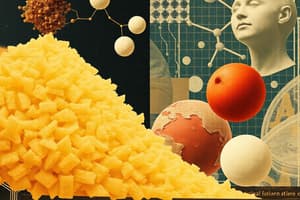Podcast
Questions and Answers
What is the characteristic of the anomeric carbon in aldoses?
What is the characteristic of the anomeric carbon in aldoses?
- It is the carbon derived from the carbonyl group. (correct)
- It is the carbon furthest from the carbonyl group.
- It is the least reactive carbon.
- It is the first carbon in the chain.
Which of the following accurately describes the difference between alpha and beta anomers?
Which of the following accurately describes the difference between alpha and beta anomers?
- They are identical structures.
- They differ only by one hydrogen atom.
- They differ in the configuration of the hydroxyl group on the anomeric carbon. (correct)
- They differ in the position of the carbonyl group.
What type of sugar acid is produced when the aldehyde group of glucose is oxidized to a carboxyl group?
What type of sugar acid is produced when the aldehyde group of glucose is oxidized to a carboxyl group?
- Sugar alcohol
- Aldonic acid (correct)
- Uronic acid
- Aldaric acid
In which of the following structural representations does glucose predominantly appear in solution?
In which of the following structural representations does glucose predominantly appear in solution?
How many carbon atoms are in the furanose ring structure?
How many carbon atoms are in the furanose ring structure?
What is the term used to describe the relationship between galactose and mannose?
What is the term used to describe the relationship between galactose and mannose?
Which of the following correctly identifies a characteristic of the pyranose ring?
Which of the following correctly identifies a characteristic of the pyranose ring?
Which monosaccharide is commonly found in a furanose form among ketohexoses?
Which monosaccharide is commonly found in a furanose form among ketohexoses?
Which type of glycosidic bond is present in sucrose?
Which type of glycosidic bond is present in sucrose?
What characteristic differentiates maltose and isomaltose?
What characteristic differentiates maltose and isomaltose?
Which of the following sugars is classified as a non-reducing sugar?
Which of the following sugars is classified as a non-reducing sugar?
In the structure of starch, which component is primarily responsible for the branching?
In the structure of starch, which component is primarily responsible for the branching?
What type of glycosidic bond links the glucose units in cellulose?
What type of glycosidic bond links the glucose units in cellulose?
Which of the following is a feature of glycogen compared to starch?
Which of the following is a feature of glycogen compared to starch?
Which of the following describes a defining feature of reducing sugars?
Which of the following describes a defining feature of reducing sugars?
What molecular structure is essential for the reactivity of monosaccharide derivatives?
What molecular structure is essential for the reactivity of monosaccharide derivatives?
Which of the following refers specifically to the type of isomerism where two compounds are nonsuperimposable mirror images of each other?
Which of the following refers specifically to the type of isomerism where two compounds are nonsuperimposable mirror images of each other?
What distinguishes anomeric carbons in a monosaccharide?
What distinguishes anomeric carbons in a monosaccharide?
Which of the following monosaccharides is an example of an aldohexose?
Which of the following monosaccharides is an example of an aldohexose?
What type of projection shows the three-dimensional arrangement of atoms in a monosaccharide?
What type of projection shows the three-dimensional arrangement of atoms in a monosaccharide?
Which compound is recognized as a ketopentose?
Which compound is recognized as a ketopentose?
What reaction describes the conversion of a monosaccharide into a sugar acid?
What reaction describes the conversion of a monosaccharide into a sugar acid?
Which monosaccharide derivative is specifically synthesized in the mammary gland to produce lactose?
Which monosaccharide derivative is specifically synthesized in the mammary gland to produce lactose?
Which of the following would be classified as an epimer?
Which of the following would be classified as an epimer?
Flashcards
Pyranose ring
Pyranose ring
A cyclic form of a monosaccharide with a six-membered ring, containing 5 carbons.
Furanose ring
Furanose ring
A cyclic form of a monosaccharide with a five-membered ring, containing 4 carbons.
Anomeric carbon
Anomeric carbon
Carbon atom that becomes chiral when carbonyl group is cyclic. C-1 in aldoses & C-2 in ketoses.
Anomers
Anomers
Signup and view all the flashcards
Reducing sugar
Reducing sugar
Signup and view all the flashcards
Aldonic acid
Aldonic acid
Signup and view all the flashcards
Uronic acid
Uronic acid
Signup and view all the flashcards
Aldaric acid
Aldaric acid
Signup and view all the flashcards
Monosaccharides
Monosaccharides
Signup and view all the flashcards
Aldose
Aldose
Signup and view all the flashcards
Ketose
Ketose
Signup and view all the flashcards
Isomerism
Isomerism
Signup and view all the flashcards
Chiral carbon
Chiral carbon
Signup and view all the flashcards
Enantiomers
Enantiomers
Signup and view all the flashcards
Isomaltose
Isomaltose
Signup and view all the flashcards
Sucrose
Sucrose
Signup and view all the flashcards
Homopolysaccharides
Homopolysaccharides
Signup and view all the flashcards
Heteropolysaccharides
Heteropolysaccharides
Signup and view all the flashcards
Starch
Starch
Signup and view all the flashcards
Glycogen
Glycogen
Signup and view all the flashcards
Study Notes
Medical Biochemistry and Molecular Biology
- Course taught by Dr. Mohamed Ahmed Abdelmoneim
- Arish University, Faculty of Medicine
Carbohydrates Chemistry
- Carbohydrates are organic molecules, polyhydroxy aldehydes, or ketones, derivatives.
- Serve several biochemical functions, major source of metabolic energy for plants and animals, making up 60% of our diet.
- Used in the biosynthesis of ATP, cell membranes, cell receptors, RNA, DNA, vitamins (B2 and C).
- Form structural elements like chitin in animals and cellulose in plants.
- Form fibers that lower blood glucose and cholesterol levels, preventing constipation.
- Dietary sources include fruits, vegetables, legumes, grains, milk, soft drinks, and corn.
Classification of Carbohydrates
- Monosaccharides: Single sugar unit (e.g., glucose, fructose, galactose).
- Disaccharides: Two sugar units (e.g., maltose, sucrose, lactose).
- Oligosaccharides: 3 to 10 sugar units.
- Polysaccharides: More than 10 sugar units (e.g., starch, glycogen, cellulose, inulin).
Monosaccharides
- Single sugar unit, simplest carbohydrates.
- Classified according to the presence of an aldehyde or ketone group:
- Aldoses: Contain an aldehyde group (CHO).
- Ketoses: Contain a ketone group (C=O), indicated with the suffix "ulose".
- Classified according to the number of carbon atoms:
- Triose (3 carbons), Tetrose (4 carbons), Pentose (5 carbons), Hexose (6 carbons), Heptose (7 carbons).
- Important monosaccharides include ribose (RNA, ATP, GTP, NAD, FAD), deoxyribose (DNA), glucose (blood sugar), fructose (fruit sugar, semen), galactose (milk sugar), mannose.
Biological Importance of Monosaccharides
- Ribose is a component of RNA, ATP, GTP, NAD, and FAD.
- Deoxyribose is part of DNA.
- Glucose is a major blood sugar and important carbohydrate.
- Fructose is a main sugar in semen.
- Galactose is synthesized in the mammary gland to create lactose in milk.
- Fructose and galactose are converted to glucose in the liver.
- Mannose is a component of many glycoproteins.
Asymmetric Carbon (Chiral)
- Any carbon atom attached to four different atoms or groups.
- Example is the middle carbon of glyceraldehyde.
Isomerism
-
Ability of a substance to exist in more than one form (isomers).
-
Types of Isomers:
- Structural isomers: Different order of atom attachment.
- Stereoisomers: Different spatial arrangement.
- Enantiomers: Non-superimposable mirror images (opposite configuration at each chiral carbon).
- Diastereomers: Non-mirror image stereoisomers.
- Epimers: Differ in configuration at only one chiral carbon.
- Anomers: Differ in configuration at the anomeric carbon (the carbon that forms the ring).
-
Optical activity: Ability of a substance to rotate the plane of polarized light.
D and L configurations
- Related to the position of the hydroxyl group (-OH) on the asymmetric carbon.
- D form: OH group is on the right side.
- L form: OH group is on the left side.
- Most monosaccharides in mammals are in the D configuration,
Monosaccharide Derivatives
- Aldoses oxidized to various acids (Aldonic, Uronic, Aldaric).
- Importance of Glucuronic acid: Often linked to xenobiotics, bile and steroid hormones.
- 2-Deoxy Sugars: Replacing an -OH group with a hydrogen atom (e.g., deoxyribose in DNA).
- 3-Amino Sugars: Replacing an -OH group with an amino group (e.g., glucosamine in heparin/hyaluronic acid, galactosamine in chondroitin sulfate).
Importance of Amino Sugars
- Formation of glycoproteins, proteoglycans, and gangliosides.
- Some antibiotics (e.g., erythromycin) contain amino sugars.
Glycosidic Bond
- Bond between a carbohydrate and another compound/molecule forming complex carbohydrates .
- The linkage occurs between the OH of anomeric carbon and another compound.
- Glycone: sugar unit
- Aglycone: non carbohydrate
Glycosides
- Compounds formed by condensation between monosaccharides and other compounds.
- Examples include disaccharides, sugar nucleotides, some antibiotics (e.g., streptomycin), and cardiac glycosides (e.g., digitalis).
Disaccharides
- Two monosaccharides linked by a glycosidic linkage.
- Examples include maltose (2 α-glucose), isomaltose (2 α-glucose), lactose (β-glucose + β-galactose), and sucrose (α-glucose + β-fructose).
Polysaccharides
- Composed of more than 10 monosaccharide units linked by glycosidic bonds.
- Homopolysaccharides: Composed of repeated units of one type of monosaccharide (e.g., starch, glycogen, cellulose, inulin).
- Heteropolysaccharides: Composed of repeated units of different types of monosaccharides (eg. Pectins, Glycosaminoglycans).
Glycoproteins and Proteoglycans
- Glycoproteins: Primarily protein with some carbohydrates (10-15%).
- Proteoglycans: Primarily carbohydrates with some proteins (50-60%).
- Examples include collagens, mucins, transferrin, immunoglobulins, other extracellular matrix molecules, plasma proteins, blood group antigens, cell receptors, hormones, enzymes, and immunoglobulin.
Complex Carbohydrates
- Carbohydrates attached to non-carbohydrate molecules via glycosidic bonds.
- Molecules included are Purines & pyrimidines (Nucleic acids), Proteins (in glycoproteins & proteoglycans), Lipids (Glycolipids), Aromatic rings (in steroids & bilirubin).
Studying That Suits You
Use AI to generate personalized quizzes and flashcards to suit your learning preferences.




